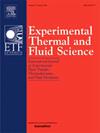低漩涡配置对氨-甲烷-空气预混合漩涡火焰稳定性极限和排放特性的影响
IF 2.8
2区 工程技术
Q2 ENGINEERING, MECHANICAL
Experimental Thermal and Fluid Science
Pub Date : 2024-11-19
DOI:10.1016/j.expthermflusci.2024.111361
引用次数: 0
摘要
最近,氨作为一种零碳燃料和氢的载体受到了广泛关注。然而,其火焰不稳定性和排放仍然是主要挑战。在这项研究中,研究了低漩涡配置对不同当量比和氨混合比下氨-甲烷-空气预混合漩涡火焰的稳定性极限和排放的影响。低漩涡配置是通过在非漩涡流和漩涡流中使用三个具有不同质量通量比(Rm)的中心通孔漩涡器来实现的。结果表明,在 Rm = 0 % 时,火焰表现出热声不稳定性,在氨气混合比小于 60 % 的所有条件下,均检测到较高的排放。相比之下,Rm = 25 % 和 Rm = 49 % 的漩涡器在所有运行条件下都能确保火焰稳定。Rm = 25 % 的漩涡器有效减少了约 30 % 的氮氧化物排放,同时略微缩小了稳定极限。CO 和未燃烧 NH3 的排放量也显著减少,但 N2O 的排放量却有所增加。这是由于非旋流降低了火焰温度,从而抑制了 N2O 的热裂解。当 Rm = 49 % 时,虽然排放量进一步减少,但稳定极限变得非常狭窄。同时还发现,Rm 的增加导致火焰结构从 V 形转变为 W 形,火焰明显抬升,流场中的再循环区缩小。这些变化导致了不同低漩配置下稳定极限和排放的转变,为氨作为燃气轮机燃料提高燃烧效率和减少排放提供了可行的思路。本文章由计算机程序翻译,如有差异,请以英文原文为准。
The effect of low swirl configurations on stability limits and emission characteristics in premixed ammonia-methane-air swirling flames
Ammonia has recently gained significant attention as a zero-carbon fuel and a carrier of hydrogen. However, its flame instability and emissions remain major challenges. In this study, the effect of low swirl configuration on stability limits and emissions of premixed ammonia-methane-air swirling flames at various equivalence ratios and ammonia blending ratios were investigated. The low swirl configuration was achieved by using three center through-hole swirlers with different mass fluxes ratio (Rm) for non-swirling and swirling flows. The results showed that the flames exhibited thermoacoustic instability at Rm = 0 % and detected higher emissions for all conditions where the ammonia mixing ratios are less than 60 %. By contrast, the swirlers with Rm = 25 % and Rm = 49 % ensured flames stabilization under all operating conditions. The swirler with Rm = 25 % effectively reduced NOx emissions about 30 % while slightly narrowing the stability limits. CO and unburned NH3 emissions also decreased significantly, but N2O emissions increased. This was due to the non-swirling flow reduced the flame temperature, which inhibited the thermal cracking of N2O. As Rm = 49 %, the stability limits became very narrow, although the emissions decreased further. In conjunction, it is found that increasing Rm caused the flame structure to shift from the V-shape to the W-shape, with the flame obviously lifting and the recirculation zone in the flow field shrinking. These changes are responsible for the transformation of the stability limits and emission with different low swirl configurations, which provide a feasible idea for use of ammonia as a gas turbine fuel to improve combustion efficiency and reduce emissions.
求助全文
通过发布文献求助,成功后即可免费获取论文全文。
去求助
来源期刊

Experimental Thermal and Fluid Science
工程技术-工程:机械
CiteScore
6.70
自引率
3.10%
发文量
159
审稿时长
34 days
期刊介绍:
Experimental Thermal and Fluid Science provides a forum for research emphasizing experimental work that enhances fundamental understanding of heat transfer, thermodynamics, and fluid mechanics. In addition to the principal areas of research, the journal covers research results in related fields, including combined heat and mass transfer, flows with phase transition, micro- and nano-scale systems, multiphase flow, combustion, radiative transfer, porous media, cryogenics, turbulence, and novel experimental techniques.
 求助内容:
求助内容: 应助结果提醒方式:
应助结果提醒方式:


